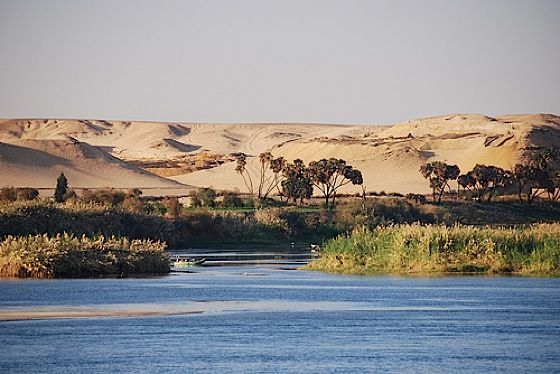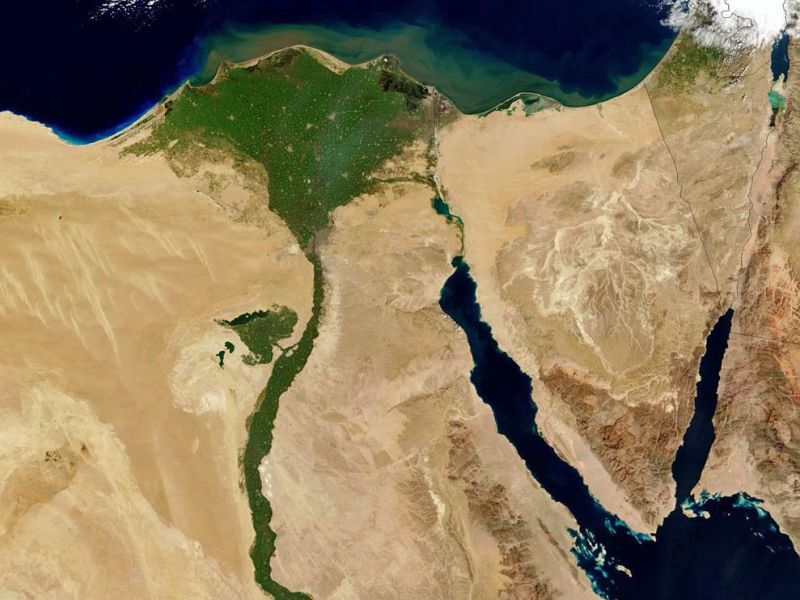Egypt’s Continuing Water Crisis: Four Years Later
Published on by Amir Dakkak, Water Source - Founder and CEO in Academic
With climate change’s threat increasing every day, Egypt is struggling to cope with water shortages and food production.
 It is expected that Egypt’s per capita annual water supply will drop from 600 cubic meters today to 500 cubic meters by 2025. This is the UN threshold for absolute water scarcity.
It is expected that Egypt’s per capita annual water supply will drop from 600 cubic meters today to 500 cubic meters by 2025. This is the UN threshold for absolute water scarcity.
To put it in simpler terms, the population will not have enough water to complete their daily chores; a person will either shower, or wash the laundry.
Egypt has only 20 cubic meters per person of internal renewable freshwater resources, and as a result the country relies heavily on the Nile River for its main source of water.
Water scarcity has become so severe that it has been recorded that certain areas in the country go days without water, with pressure sometimes returning only for a few hours a week.
This has caused high tensions between the people and the government. This type of tension caused, by the lack of water, was one of the catalysts of the Arab Spring in 2011/2012. The country can no longer delay action and must act now. Below are a few aspects that have a significant influence on the water crisis in Egypt.
Agriculture
Agriculture contributes roughly 15% of Egypt’s GDP, and employs over a third of Egypt’s workforce with rice being the biggest produce in the country. Rice is an important part of an Egyptian family’s diet. However, the cultivation of rice is very water intensive. On average about 3000 liters of water are used to produce 1 kilo of rice.
This number can vary depending on climate, soil type and water management practices. This has caused the government to enforce some restriction to its cultivation. The Government has restricted cultivation of rice to an area of 1 million acres (farmers were previously able to use most of the Nile Delta for cultivation) in specified areas of the Nile Delta.
The government has even resorted to taking drastic measures such as spreading incendiary compounds on rice fields cultivated outside the area allocated by the government. This has caused outrage and demonstrations by farmers who insist that the area allocated is not enough for them to be able to make ends meet.
To alleviate population tension and unrest the government has been trying to increase water supply by exploring the reuse of treated agricultural and municipal wastewater for agriculture. However implementation of such initiatives is not being applied fast enough to cope with the rising demand.
Government must enforce new irrigation methods in the country (Egyptian farmers still rely heavily on flood and canal irrigation in the Nile Delta) as well as smart agricultural practices such as using less water intensive crops. Resorting less water intensive water crops could drastically cut water used in agriculture and help increase water supply.
However, increasing water supply and decreasing its consumption might not be enough if the pollution of the Nile persists.  Pollution of the Nile
Pollution of the Nile
The Nile has been a lifeline for Egypt at least since the time of the pharaohs.
Yet, despite the world’s largest river’s importance to the country, its water has been and still is being polluted by various sources, and its pollution has been increasing exponentially in recent years.
The pollution of the Nile is an issue that is regularly underestimated.
The Nile River pollution problem is a complex problem that has been ongoing for more than 30 years and with so many people relying on the Nile for drinking, agricultural, and municipal use, the quality of that water should be of most importance.
The waters are mainly being polluted by municipal and industrial waste, with many recorded incidents of leakage of wastewater, the dumping of dead animal carcasses, and the release of chemical and hazardous industrial waste into the Nile River.
Industrial waste has led to the presence of metals in the water which pose a significant risk not only to human health, but also to animal health and agricultural production. Fish die in large numbers from poisoning because of the high levels of ammonia and lead. Agricultural production quality and quantity has been affected by using untreated water for irrigation as the bacteria and the metals in the water affect the growth of the plant produce, especially in the Nile Delta where pollution is highest.
The government is trying to implement stricter rules on the quality and type of waste/wastewater dumped into the river to reduce the pollution of the Nile. However, more swift and decisive action must be taken towards cleaning the Nile, such as treating the wastewater prior to disposal, and placing stricter restrictions on industries to dispose of their waste safely and responsibly.
This issue cannot be ignored any further as the continual increase in population will cause an increase in demand on Egypt’s dwindling water resources. Every drop of water counts.
Conclusion
If the situation remains as it is today, Egypt runs the risk of becoming an absolute water scarce country in less than a decade, where water will not be enough to accommodate daily chores. Therefore Egypt has a battle on its hands to ensure adequate conditions for its population.
Like many other water scarce countries around the world, it needs to mitigate water scarcity by implementing smart conservation techniques, adopting water saving technologies, and control water pollution.
With climate conditions expected to get drier and heat waves expected to become more frequent in the MENA region, Egypt cannot postpone its water conservation policies anymore and must act immediately to meet the population’s water demand. It’s now or never.
Source: Arab Water Source
Media
Taxonomy
- Water
- Water Supply
- Scarcity
- Water Scarcity In Desert area
- Drought
- Access
- Agriculture & Forestry
- Government
5 Comments
-
Such an unfortunate and sad water scarcity situation that seems so dire for Egypt and clearly they need environmental standards for industrial and municipal wastewater ending up the Nile. We are polluting the life blood of people's livelihoods which will not only lead to environmental extinction but our entire species extinction. I hope the Egypt government takes notice of this really urgent issue of water scarcity and security immediately cause when people have to decide whether to shower or eat with such dwindling water supplies that is horrible and unacceptable at every level and no country no matter how poor should never make its people endure such painful and agonizing choices. Honestly Egypt needs to develop it's desal water portfolio to be more sustainable and water independent like its next door neighbor Israel has done and they'll be in much better shape to endure the future without a doubt! They need to take Israel as a model example for sustainable water management and use that to meet its goals and objectives to increase water security before it's too late.
-
unfortunately most of our water policies focusing on water supply and provision without giving any attention to the water demand management by encourage all water entities, communities public and private water sector in
-
Egypt consumes a lot of natural gas and in the exhaust of the combusted natural gas is a lot of water. With the technology of Condensing Flue Gas Heat Recovery the heat energy can be recovered and utilized and in that process distilled water is created. Today they are allowing all this water to be vented into the atmosphere and come down as rain in other parts of the world.
Next to a power plant could be constructed a large range of commercial greenhouses and the recovered heat energy from the exhaust could be used to cool or heat these glass or plastic buildings. Inside the greenhouses food crops can be grown. Africa will never have to much food being produced, and then there are all the full time jobs that will be created.
-
Need to prioritize water allocation
1 Comment reply
-
Dear Adeyemi: Your greatest asset is actually the contaminants in the Nile. Our website WaterSmart Environmental, Inc. explains how contaminants can be converted into methane gas (that can be used to produce electricity) and carbon dioxide gas (that can be converted into two biofuels (biodiesel and biomethanol--substitutes for diesel and gasoline). Our website contains more than 7,000 pages that discuss renewable energy. With Warm Regards-Chuck
C. G. (Chuck) Steiner
President and CEO
WaterSmart Environmental, Inc.
PO Box 26346
Shawnee Mission, Kansas 66225-6346
Phone: 913-703-5445
Fax: 913-703-5445
URL: www.freewaterindependence.com
PS: I am quite willing to travel to Egypt at your expense for the purpose of explaining each and every step necessary in order for your country to achieve renewable energy independence within the next 12 months.
-
-
We often repeat the word crisis and begin to believe in it ... But the main thing - to be a crisis in your head. His is not the ability to change something we write off the crisis ... Here and Egypt. Main Problem - no grip drinking and industrial water. And now the question - whether the people in the area to pay for water, if it is to file ??? It remains only to find out the cost of the water. Modern technologies allow to get drinking water from salty or sea water at a cost of no more than 0.05 USD per 1m3, which is sometimes less than the cost to bring water from a deep well. And the volume of desalination can be up to 12 000 m3 in the same installation, and brine in refining can be developed into the sea salt - the same commercial product.
The question remains - is there any one person or organization that is willing to take on the issue of water supply ??? That's where the crisis begins.
On the technical side of the issue with the cost of desalination has long been settled.tumentsev@inbox.ru
1 Comment reply
-
Dear Sergei,
What you say is only partially correct (for those living in low lying coastal regions. Others will have to be supplied by pumping, perhaps over long distances to much higher elevations. Besides the monetary cost, what are the likely environmental costs for this?
-